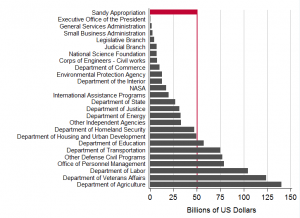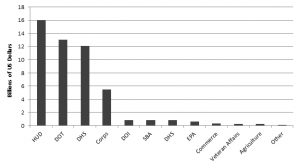The Sandy Supplemental by the Numbers

Figure 1. Sandy Supplemental Compared with 2012 Agency Outlays
Source: Fiscal Year 2014 Historical Tables Budget of the US Office of Management and Budget.
The amount of federal spending on disaster aid has been growing over time. Hurricane Sandy resulted in an enormous level of supplemental appropriations. For perspective, we compared the Sandy supplemental appropriation, more than $50 billion, with the 2012 federal outlays by agency, excluding entitlement programs, military spending, and debt payments, as shown in Figure 1. The Sandy supplemental was greater than the amount spent by the Environmental Protection Agency, National Aeronautics and Space Administration, State Department, Department of Justice, Department of Energy, and many others.
More than 90 percent of the supplemental appropriations for Hurricane Sandy went to four departments: the Department of Housing and Urban Development (HUD), Department of Transportation (DOT), Department of Homeland Security (DHS), and the US Army Corps of Engineers (Corps). The (pre-sequester) amounts appropriated to each are shown in Figure 2.
Of note, HUD received greater appropriations than FEMA, the traditional source of disaster aid. Since Hurricane Katrina (2005), a large share of aid has been channeled to local governments through Community Development Block Grants (CDBG) administered by HUD, as opposed to the traditional FEMA programs. Given the enormous flexibility state and local governments have in how they spend CDBG money, it is difficult to say definitively how it is used or what this shift means for communities, taxpayers, or disaster victims. For this reason, the increase in CDBG spending requires a careful analysis of how the funds have been and might be spent and raises the important policy question of whether CDBGs are the most appropriate vehicle for federal disaster aid.

Figure 2. Sandy Appropriations, by Department
Source: Disaster Relief Appropriations. Public Law 113-2 (2013).
A large share of the $50 billion supplemental has yet to be spent, making complete analysis not yet possible. There are two things that are known, however. First, individuals and households will receive only a small fraction of Sandy funds. The rest will go to infrastructure repair, compensation to local governments and businesses, and investments in hazard mitigation. This brings us to the second point: the Sandy supplemental will fund many projects not related to emergency relief and recovery, exempting these projects from the usual budgetary scrutiny. Many of these projects are designed to reduce damages from future events. Federal investments in reducing future hazards and climate adaptation may be justified. However, if Congress is going to spend billions of dollars on future risk reduction, a more deliberate approach would evaluate risks around the country, assess the risk reduction investments, and then allocate funding to maximize the benefits. Many activities funded by the Sandy supplemental may rise to the top of such an analysis, but that evaluation did not take place. Read more on this topic in our recent RFF issue brief.
About Leonard A. Shabman
Leonard Shabman is a resident scholar at Resources for the Future.
- Web |
- More Posts (2)
About Carolyn Kousky
Carolyn Kousky is a fellow at Resources for the Future. Her research focuses on natural resource management, decisionmaking under uncertainty, and individual and societal responses to natural disaster risk.
- Web |
- More Posts (10)

 Subscribe; to our RSS Feed
Subscribe; to our RSS Feed Tweets by @RFF_org
Tweets by @RFF_org 